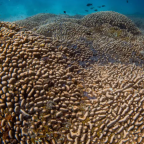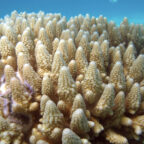
Coral reefs have long faced problems like overfishing, global warming and pollution—but they’re also threatened by how slow they regenerate. To reproduce, coral release sperm and eggs and form larvae, which then swim around and attach to a surface, where they begin to develop into coral polyps and grow. They face a variety of competitors, and most don’t survive. If they do survive, it takes years for the coral to be able to reproduce, and even longer for entire reefs to form.
Researchers at the Carl R. Woese Institute for Genomic Biology (IGB) at the University of Illinois want to increase the rate of coral regeneration by creating a new home for coral larvae: artificial structures that encourage larvae settlement and discourage the growth of competitor species.
The research will be led by IGB faculty member Amy Wagoner Johnson, a professor of mechanical science and engineering, along with four Co-PIs including IGB faculty Bruce Fouke, Professor of Geology and of Microbiology, Gabriel Juarez, Assistant Professor of Mechanical Science and Engineering, Forest Rohwer, Professor of Biology at San Diego State University, Kristen Marhaver, and collaborator Mark Vermeij. Marhaver and Vermeij are two leading coral scientists at CARMABI Research Station, a field site on the Caribbean island of Curaçao that studies coral reefs, and the site of the fieldwork for this research.
Last year, Wagoner Johnson had the idea to apply her research on bone regeneration to coral research.
“We thought it would be really interesting if we could take some of the things we’ve learned from tissue engineering—cells interacting with materials and what kinds of factors influence cells . . . and apply that to coral reproduction,” she said.
She will use her background in material science to design artificial structures for the coral larvae to settle on, while Juarez will build a water tank to test how the larvae interact with the structures and the flow of the water.
“When you take a closer look, it turns out that these organisms are able to sense things, like chemical gradients and fluid forces,” Juarez said. “They have complicated little sensing systems. They haven’t been studied much in this way. This work will hopefully allow us to at least get insight into whether they actually are a bit more autonomous than we think.”
By testing different materials, they’ll learn which materials and surface structures are ideal for larvae settlement.
“Once we understand more about the surface, then we should be able to replicate that surface on something larger that is deployable on a larger scale,” Wagoner Johnson said. “The idea is to understand more of the immediate interactions and do it in a very systematic way.”
Fouke, who has studied the coral reefs of Curaçao for almost 30 years, will provide the overall geobiological context of the ecology and evolution of the reefs. He will also make detailed analyses of the coral skeleton as it grows.
The team is funded by a three-year NSF Growing Convergence Research Grant, which encourages collaboration between scientists who don’t typically work together.
As a mix of engineers and biologists, the team will first need to learn more about each other’s fields. They’ll do this through a series of workshops at the CARMABI Research Station in Curaçao, which is home to some of the world’s leading experts on culturing coral larvae.
“They’ll teach us about larval culture, collecting samples, so we’ll have to learn to scuba dive before we go,” Wagoner Johnson said. “Then we’ll teach them some engineering principles, some fluid mechanics, some materials science, and 3-D printing. That way we’ll be cross-fertilizing the disciplines in a very targeted way.”
In doing so, the team hopes to create a new area of research: coral reef engineering.
“There is not a lot of work that has been done in this area,” Wagoner Johnson said. “We really think that the potential is there to make significant impact.”
That’s good news for coral reefs, which bring food security, biodiversity, and even economic growth from fishing and tourism.
“We see it in the news all the time that coral reefs are endangered, and there are many statistics about how they’re dying,” Wagoner Johnson said. “Being able to more efficiently regenerate coral can contribute a little bit to resolving the issue of losing the coral reefs.”















Social Profiles